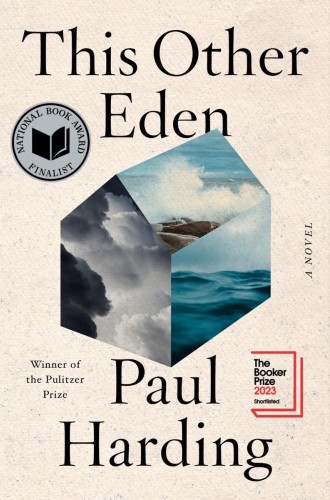An island in the storm
Paul Harding’s evocative novel begins with the 1815 hurricane off the New England coast.

This Other Eden
A Novel
Violent storms often mark turning points in epic narratives. King Lear staggers across a windswept heath, bemoaning the loss of his kingdom and his mind. Battered by a hurricane in the Florida Everglades, Zora Neale Hurston’s characters shelter in their flimsy shanties; “they seemed to be staring at the dark, but their eyes were watching God.” Storms pummel the Yorkshire moors when a spurned Heathcliff runs from the house of his beloved in Emily Brontë’s Wuthering Heights. At the apex of Wes Anderson’s Moonrise Kingdom (a film that derives its structure in part from Benjamin Britten’s opera Noye’s Fludde) a great storm wreaks destruction on a village.
A storm of biblical proportions ravages the New England coast in the opening pages of Paul Harding’s This Other Eden. Patience Honey, an immigrant from Ireland who had settled on an uninhabited Maine island two decades earlier with her African husband, runs outside just before the storm smashes her house into splinters, thinking to herself that “this was the Judgment and what was to be was to be; it was useless to try to outrun the outstretched arm of the Lord.” Benjamin and Patience sweep up their grandchildren in their arms and climb the tallest tree on the island. As the tree sways and nearly snaps in the gale, they watch the floodwaters destroy homes and farms and orchards and then at last subside. Some family members and neighbors who climb up after them are spared; others are swept away and drowned.
Read our latest issue or browse back issues.
Like the great biblical flood, which causes both the near destruction and the renewal of the human family, the hurricane of 1815 decimates but does not destroy the mixed-race community on the island. Apple Island is “a granite pebble in the frigid Atlantic,” separated from the mainland by just 300 feet of tidal shallows—and by an unbridgeable gulf of racial prejudice and social isolation.
The story of the storm is recounted nearly a century later by the first settlers’ great-granddaughter Esther, who presides from her rocking chair over two more generations of the Honey family. She is the matriarch, too, of a ragged community of outcasts and misfits, the “distillate of Angolan fathers and Scottish grandpas, Irish mothers and Congolese grannies, Cape Verdean uncles and Penobscot aunts, cousins from Dingle, Glasgow, and Montserrat.” Living in rough-hewn cabins, repurposed fishing vessels, and a hollowed-out tree, a dozen island dwellers eke out a living from farming, fishing, gathering berries, and providing day labor and laundry services for mainland families.
Like Hurston, who describes an actual storm (the Okeechobee hurricane of 1928, one of the most powerful ever recorded) in Their Eyes Were Watching God, Harding builds This Other Eden on a foundation of history. The Great September Gale of 1815 destroyed 500 homes and took 38 lives in New England. And a tiny coastal island, Malaga Island, was uninhabited until a formerly enslaved man and his White wife settled there in 1794, raised a family, and were joined by a few others seeking refuge from societal scorn. The isolated Eden of their descendants ended in 1911 with forcible eviction, not by angels bearing swords but by state authorities who determined by precise cranial measurements, applying the fashionable science of eugenics, that generations of racial mixing had produced a population of subhumans. Some of the residents were committed to the Maine School for the Feeble-Minded. This history is documented in local sources and state records.
But Harding’s novel is a work of imagery and imagination, not history. He invites us to inhabit the lives and worlds of characters he has created. “I think of my writing as interrogative,” he told a New York Times interviewer: “You just go in there, and you just listen and look and describe.” What Harding hears as he listens is a rich tapestry of unexpected analogies, vivid images, and arresting descriptions of hardscrabble lives.
When arrangements are made for Ethan, one of the Honey children who has shown a talent for drawing, to lodge with a wealthy friend on the mainland—a possibility only because the boy can pass for White—the islanders send him off with a great feast. There are oysters and lobsters from the ocean, corn from the fields, truffles from the forest, and beer from who knows where. The islanders sing hymns, sea shanties, and “women’s desolate, joyous songs.” It is an event never before experienced, never to be repeated. “The islanders were so used to diets of wind and fog, to meals of slow-roasted sunshine and packed storm clouds, so used to devouring sautéed shadows and broiled echoes; they found themselves stupefied by such an abundance of food and drink.”
Everywhere on the island, and in the lives of its residents, there are layers of light and layers of darkness. Esther is tormented by memories of the monster who was her father. The missionary teacher who builds the first school on the island to broaden the horizons of its children—one of whom quickly grasps advanced mathematics, another the composition of Latin poetry—cannot shake his belief in a hierarchy of higher and lower races. The oldest island resident (by appearance, since no one knows anyone’s year of birth) is a hermit who carves elaborate biblical tableaux into the hollow tree that he lives in. Later he decides it is a pointless exercise and sets fire to the tree.
Harding uses evocative phrases on nearly every page. “Evening came over the meadows,” he writes, “and the haystacks lowered into deep blues and purples as the sky flared and lowered, too.” He relishes the arcane vocabulary of fishers and farmers and foresters: we observe a tedder in the hayfields, a drail on a fishing line, a thwartsaw and a froe in the forest, and a young workman peening a scythe.
At times, biblical themes come to the surface. Sketching a dead bird, young Ethan ponders whether Noah’s family “found the bodies of the drowned everywhere they went, jammed under boulders, slung in the tops of dead trees, splayed on the plains.” The schoolteacher explains in a sermon that the Genesis version of the flood of Gilgamesh proclaims the unity of the entire human family, a doctrine of which he hasn’t managed to convince himself. As government representatives draw up eviction orders, we are told: “Lawyers are filing documents. Judges are signing orders. Scientists and doctors are collecting data. Pharaoh’s heart is as hard as ever.”
This is a novel about race, poverty, loyalty and betrayal, the horrors of eugenic science, and the cruelty of the powerful. All of those themes are present. But beyond that, it is a narrative whose poetry and imagery shed light on the inner lives of people with whom readers have nearly nothing, and nearly everything, in common.





